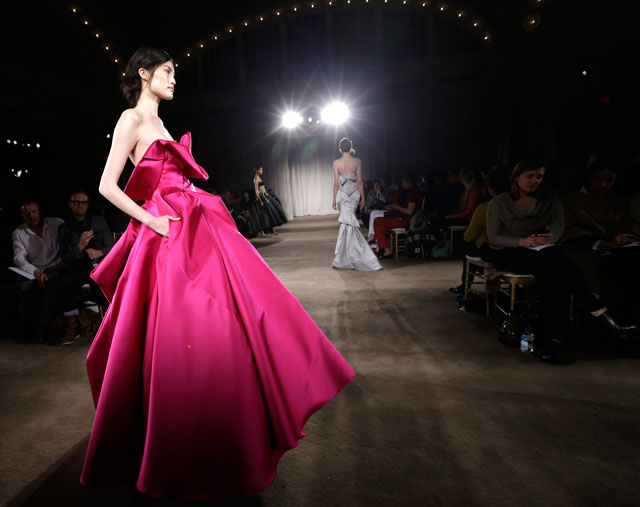Opinion: The Thing About New York Fashion Week...
Bloggers and pics outside tents are given more attention than the collections.
Feb. 16, 2013— -- The thing about New York Fashion week is that it has become an over-commercialized social gathering where what's happening outside the tents is as important as the show going on inside. Bloggers and photographers are given as much attention as the designers and their collections. I love street style as much as the next 20-something-year-old girl, but during Fashion week I like to see what new fashion is coming out of the designers.
New York is the first stop of the four fashion weeks around the world -- next is London, then Milan, and finally Paris. Being the first of the four puts a lot of pressure on NYFW to kick off the season with the best parties, most celebrity sightings, and, you guessed it, some runway shows too. But, as Refinery 29 asked it best, "When did Fashion Week start to feel like Coachella?"
I see more photos from outside Lincoln Center than I do from the collections. I agree it's interesting to see how "the common folk" have put together pieces from prior seasons (which I still don't understand how they all can afford) and strut their stuff with their SLRs taking pictures of each other from close up, from afar, from the perspective of their handbags... you get it. If you go to any fashion site that covers the shows, as soon as a show is over you'll see 3-4 slideshows available: the runway, close-ups of the accessories from the runway, who was sitting front row and what celebrities were in attendance. Two out of four have nothing to do with the collection. And if you go to any fashion bloggers' site you'll find three photos from the catwalk and about 95 photos of people standing around outside. For an event that's meant to display a designer's new designs, there isn't a quarter as many photos on the actual clothing.
It shouldn't be a surprise that NYFW includes the highest number of emerging designers of the four cities. American fashion is just newer to the industry than French, Italian, or English fashion is. And because most of the designers are my age and have just graduated from - or dropped out of - Parsons, the shows seem more like popularity contests than artistic displays. Lines like Marchesa and Peter Som are among the exceptions (their Fall 2013 collections were amazing), but if you look through this past week's shows there was little else that stood out.
 Marchesa
Marchesa
Like Billy Reid's Fall 2013 Ready-To-Wear collection. I don't care what Style.com says, the show looks like it could've been Ralph Lauren with its dandy-like women-suits and dapper wool overcoats -- boring.
 Billy Reid
Billy Reid
Cushnie et Ochs displayed the same side-cut-out dress we've been seeing for the past year but threw in a little splash of galaxy print that has been over used at this point. There were no new prints or silhouettes that stood out. Derek Lam, who used to amaze me with his print selection and combinations, also felt flat. It was all-around unmemorable because we've seen these pieces a million times before.
In contrast, the Milan and Paris shows are known for their designers whose names carry great weight in the industry, and in history. Industry experts pay close attention to the creative directors and designers behind the brands, expecting them to stay loyal to the brand's vision and at the same time bringing something new to the table. It's a challenge -- and an exciting one -- to see how every season Karl Lagerfeld stays true to Chanel's tradition (heavy use of tweed and the famous Chanel suit, for example.) For the 2012 Pre-Fall collection, Lagerfeld most definitely made Coco Chanel proud, even when incorporating Indian influences or, like he did for the Chanel 2013 Resort collection, channeling Marie Antoinette.
When you watch a Chanel or Lanvin show, you know there was an actual person named Chanel or Lanvin almost a hundred years ago who revolutionized fashion at that time. Like that one time Chanel revolutionized pants for women after the war because it was uncomfortable to ride a horse in a skirt so - voila - now we have lady pants. These designers drew their inspirations from a time when art nouveau, Louis Armstrong and Al Jolson made up the "buzz-worthy" list. When Coco Chanel was making hats or pants for the first time in the early 1900s there was no social media, no Perez Hilton, no Worst Dressed lists. She used outside influences to change history, not to dress Lady Gaga in a meat suit.
What's wrong now – in my opinion – is that designers are designing for the 15-minutes of fame, for the trendy socialites of the month, or for the absurd celebrities that pop up six months. The few exceptional collections at NYFW are those which you can see the trail of inspiration that led to the final product. Some are influenced by music, film, news, art, conversations, or just about anything that causes inspiration that carries greater meaning than something that A$AP Rocky might wear.